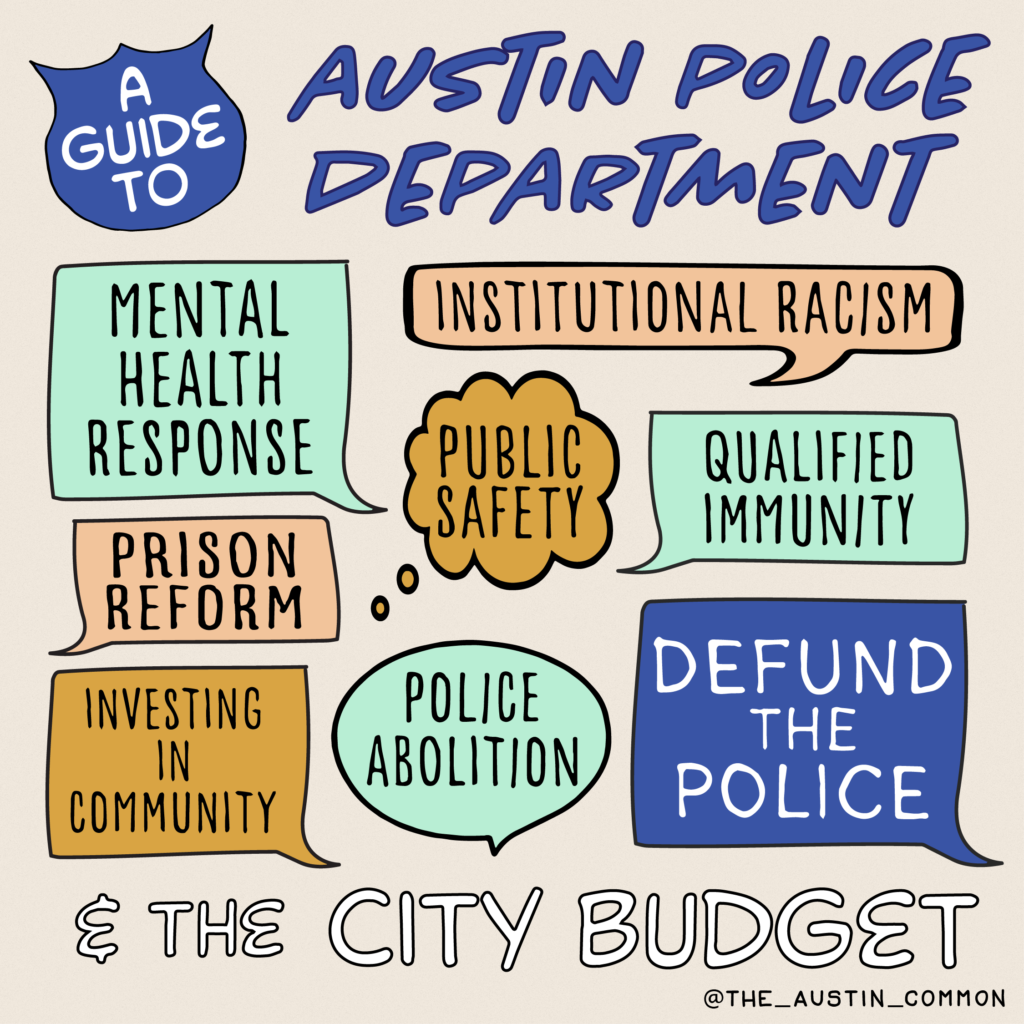
Summary
City Council is in the process of debating and revising the proposed budget for its 2020-2021 fiscal year. In this guide, we break down and explain the main point of discussion - the police department's budget.

Action Box
Have opinion's about the city's budget? Email your Council member or sign up to speak at an upcoming city budget hearing - July 30th & August 12th.
How much money should the City of Austin spend on the police? Should Austin even have a traditional police department at all? What would it look like if we dramatically changed the way we look at public safety?
These are the questions dominating this year’s city budget discussion, as Council begins the process of deliberating and changing the city manager’s proposed budget, which was released early last week.
Interested in this topic, but want to learn more? Still don’t really understand what our police budget looks like? Or what it would mean to “defund the police”?
We’ve got the answers to all your questions below.
Police Budget: The Basics
In case you’re not familiar with the intricacies of the city’s budget process. Here’s the gist.
Last week, City Manager Spencer Cronk presented an initial proposal for the city’s $4.2 billion budget, which includes everything the city spends money on – parks, libraries, Austin Energy, the airport, and of course, the police department. (For a closer look at the rest of the budget, check out our Budget 101 story from last week.)
Here’s what was in the city manager’s proposed budget, as it relates to the police department…
The city manager’s proposed budget includes $11.3 million in changes and reductions to the originally planned 2020-2021 police budget
Of that $11.3 million, $3.2 million is proposed to go back to the police department, to upgrade their records management system & to fund training related to trauma-informed response, unconscious bias & racial and cultural sensitivity, as well as training on how to administer Naloxone to someone experiencing an overdose.
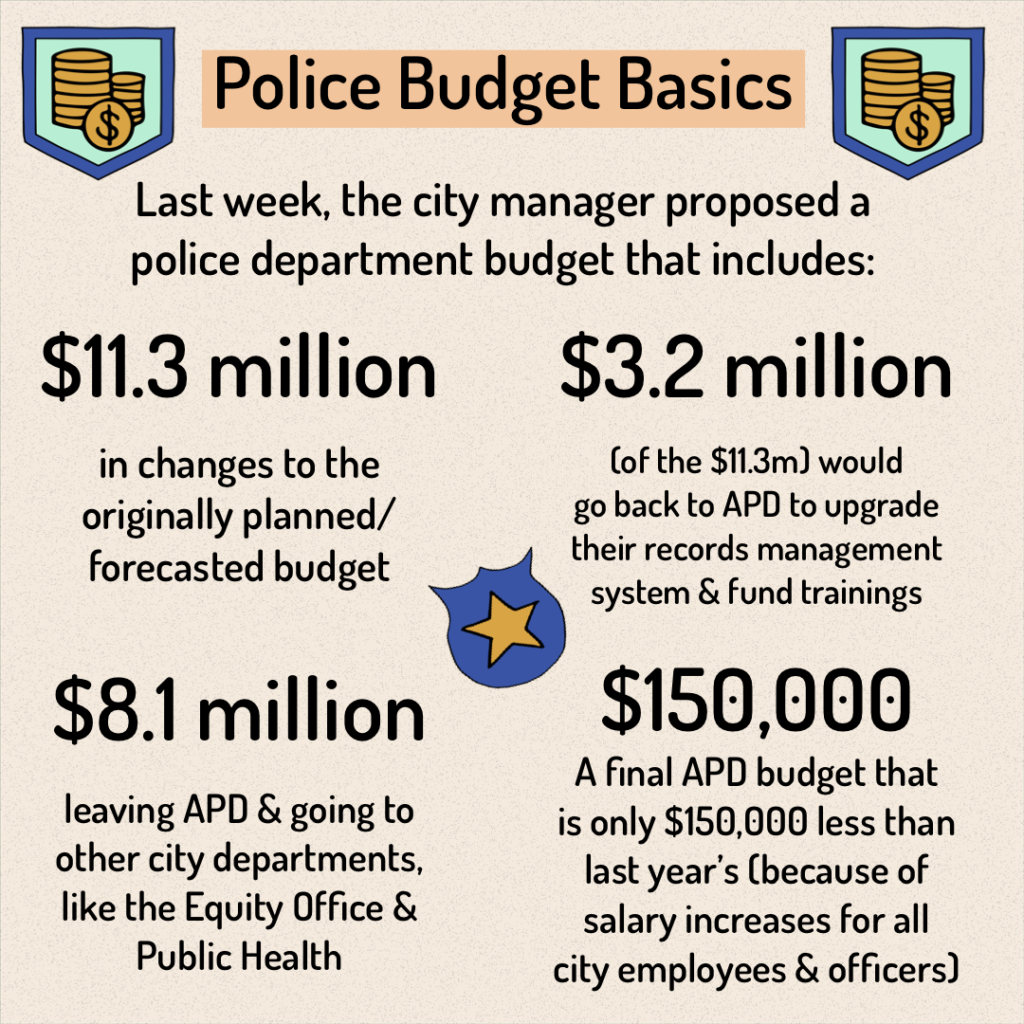
In the end, that adds up to $8.1 million leaving the police department budget and going to other city departments, including the Equity Office, Austin Public Health, and the Housing Trust Fund.
Despite these cuts to the originally planned/forecasted budget, this year’s APD budget proposal is only $150,000 less than last year’s. (That’s largely because of salary increases for all city employees & officers.) However, it is also the first time there have been any cuts to APD’s budget in years.
Even though the city manager’s proposed cuts are fairly small, he laid out the beginnings of a plan to make larger cuts down the road, suggesting that more time is needed to make more dramatic changes to APD’s budget.
In a presentation to City Council, Deputy City Manager Nuria Rivera-Vandermyde explained that the City Manager’s Office has already identified several programs currently housed in APD that might be able to be moved to civilian departments down the road, including the forensics lab, crisis intervention and mental health first response, park patrol, and the emergency call center.
In order to dive deeper into these tasks (and others that could be moved out of the police department), the City Manager’s Office is suggesting the creation of a City-Community Reimagining Task Force, centering “the voices of those who have been most impacted by police violence and institutional racism.” The task force would then convene advisory working groups and subject matter experts to dig deeper into topics like de-escalation, alternatives to policing, and homelessness response and outreach.
As Deputy City Manager Nuria Rivera-Vandermyde said, their goal is to create, “A public safety system that is accountable to the historic and disproportionate impact policing has had on our Black and Brown communities that has resulted in the dramatic overrepresentation of African American and Hispanic/Latinx individuals in our criminal justice system. And a public safety system that aims to shift the responsibility of responding to this nation’s social challenges such as mass homelessness and the increased prevalence of mental and behavioral health issues in our society to professionals in our community who can best leverage existing and future response resources to achieve better outcomes through more holistic crisis intervention and outreach.”
Community Response
For the many community organizations and advocates who (virtually) packed City Council meetings in June calling for major changes and reductions to the police department, the city manager’s proposal simply doesn’t go far enough.
“The proposed baseline budget doesn’t reflect the expressed will of the tens of thousands of community members that have contacted city officials in recent weeks or the significant immediate opportunity to safely reduce police staffing and spending,” said Chris Harris, director of the Criminal Justice Project at Texas Appleseed, in a recent Austin Justice Coalition email.
Several Council members echoed these feelings as well, with Council Member Greg Casar writing about the city manager’s proposed police budget cuts on his Facebook page that, “Compared to recent history, this is a large amount. Two years in a row, I have proposed votes to reduce police patrol by a fraction of this amount, and both proposals have failed. The reallocation of 100 police positions toward community solutions for safety is only possible because the Movement for Black Lives has changed the political reality of our time. However, the City’s response must be stronger.
I stand alongside the calls from local organizations and everyday activists demanding a $100 million reinvestment into our community’s safety from APD’s existing budget this year.”
That $100 million number has been proposed by the Austin Justice Coalition, which sent out an email after the proposed budget was released, including this statement from AJC Executive Director Chas Moore, “We are disappointed in Spencer Cronk’s budget, released today, which comes nowhere near the $100 million in cuts to the police budget that we think are appropriate. We have an opportunity right now to take this roadmap and make the change. But this budget, today, doesn’t free up enough of the money we need, and in fact it understates even Council’s modest directive to cut empty positions.”
Not surprisingly, the Austin Police Association, opposes cuts to APD’s budget, writing on their Facebook page that, “This is not the time to defund/dismantle the police department. Officers are working 60 to 75 hours a week just to make sure patrol shifts are filled. We have had several weekends in a row where our officers have responded to multiple shootings, stabbings, robberies and aggravated assaults on top of all the other 911 calls. Our officers deserve better and citizens deserve better!”
How do the police spend their time?
Earlier this month, the Austin Justice Coalition released the results of a study they commissioned, which analyzed 18 months of Austin 911 data, looking at the type of calls police respond to and how much time they spend on them.
Here’s what they found…
Only .6% of calls dealt with violent crime (homicide, rape, robbery, & aggravated assault)
21.5% of calls dealt with crime (which includes violent crime, theft, burglary, & city ordinance violations)
Responding to crime accounts for 33.2% of officer time spent on calls, with 3% of their time spent on violent crime
The study was performed by AH Datalytics, a consulting firm that has performed similar studies in cities across the US.
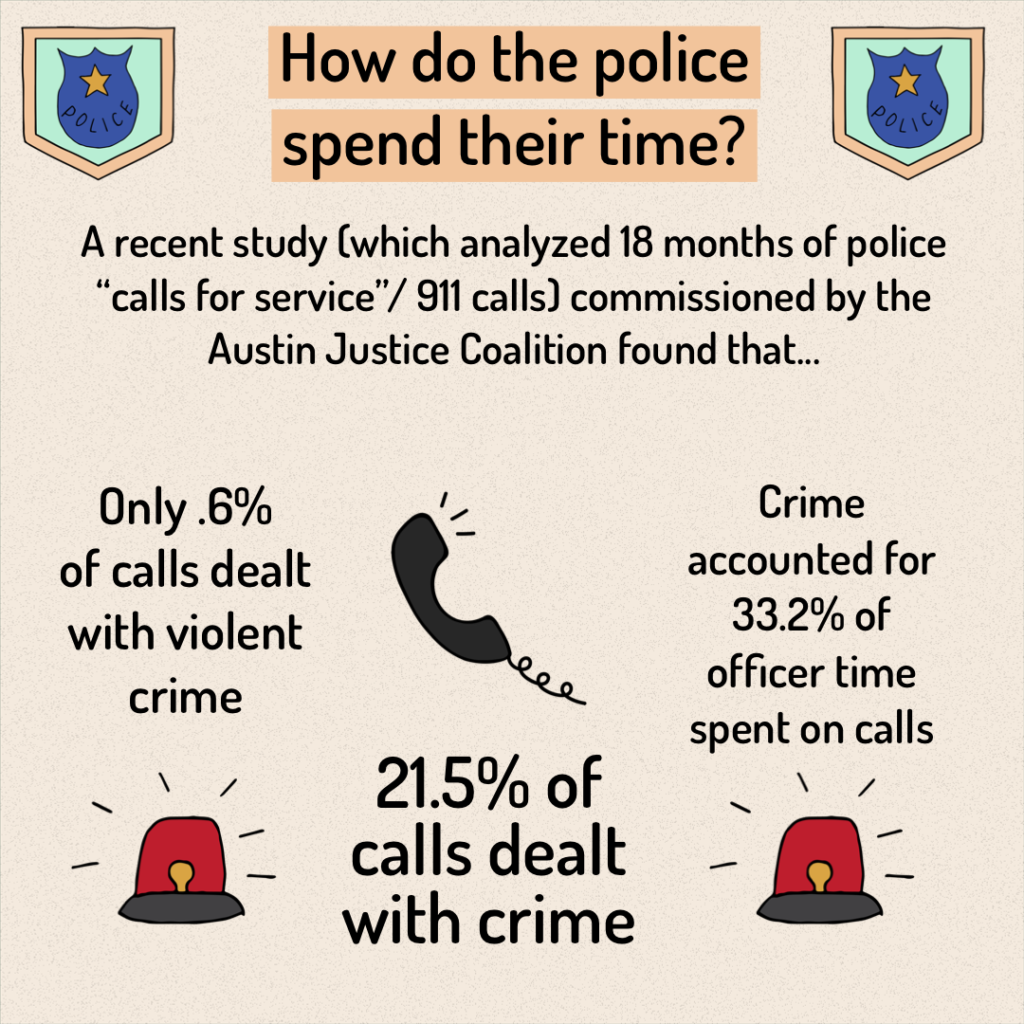
“Really what they found is what they find in almost every city where they do this analysis,” said Chris Harris in an interview with The Austin Common, “which is that the things that are used as some of the primary examples of why we desperately need police and why we always need more of them, which is to respond to imminent violent threats, really makes up a very small percentage, both of the things that police are called to do and of the time they ultimately spend doing their job.”
Of course, responding to 911 calls and “calls for service” does not capture all that a police officer does, but according to AH Datalytics, they do, “provide a snapshot as to how officers interact with members of the public.”
Ultimately, what Chris sees in this data is opportunity, to divert responsibilities that have traditionally been handled by the police department to civilian city employees or nonprofit organizations.
Alternatives To Policing - Traffic Control
Take traffic for example. The Austin Justice Coalition study found that 23.2% of the calls that APD responded to were traffic-related and that responding to these calls took up about 21% of their time.
“Sometimes there is a crime associated with an accident, but the majority of the time, that’s not the case,” Chris said. “And police end up sitting out there, writing a report, directing traffic, and that takes up a really big percentage of their time. Do we need someone with a gun, who’s primarily trained in violence, to do that?”
“That’s again, one of the many areas where there is some opportunity for us to say, the police are maybe one of the most expensive resources in the city, in terms of how much they make and their pension and everything else,” Chris said. “Is this a case where we need to put the most expensive resource in the city? I don’t see how that could be.”
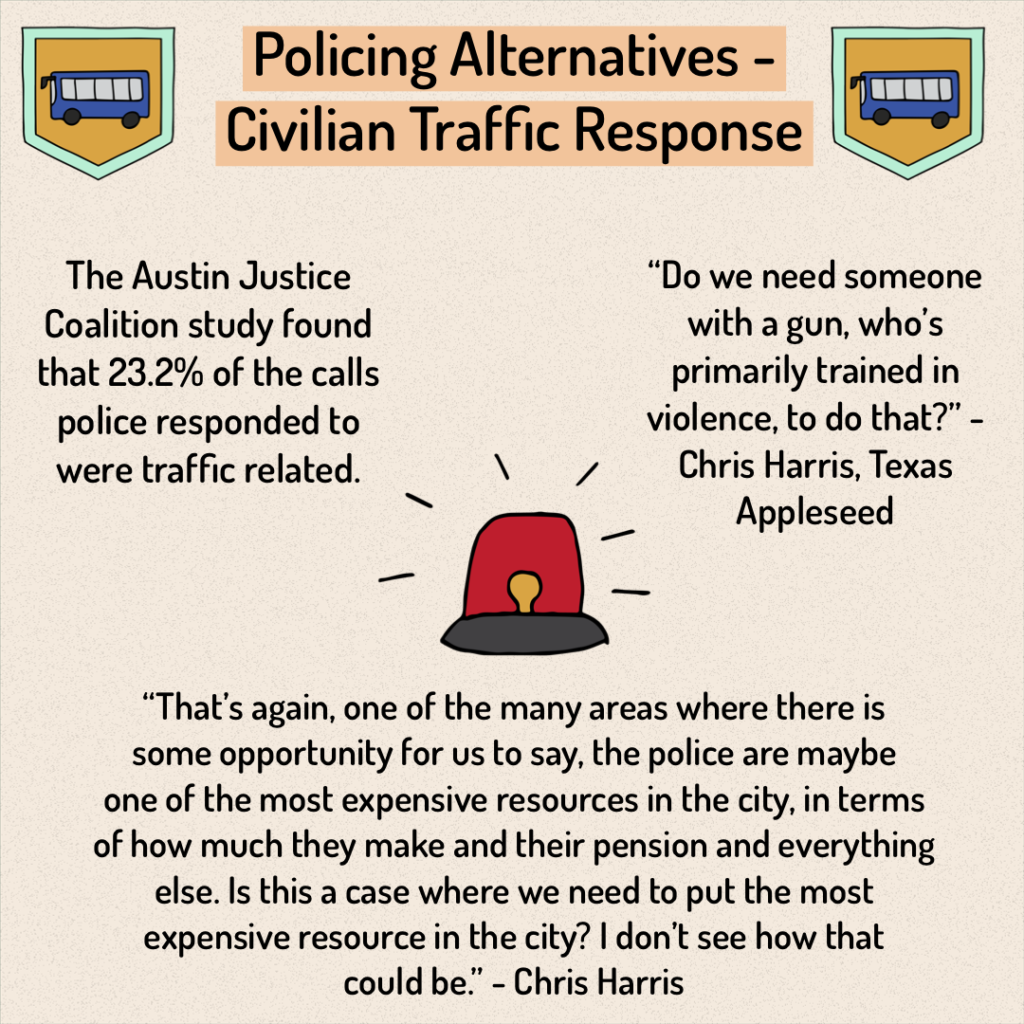
Alternatives To Policing - Harm Reduction
In addition to traffic management, activists are proposing several other alternatives to policing, asking City Council to divest money from APD and reallocate funding and responsibilities to other city departments and nonprofits.
In a livestreamed meeting hosted earlier this week (revealing the results of the WeFund budget survey) by the Austin Justice Coalition, Texas Appleseed, and the Texas Fair Defense Project, the following alternatives were shared:
Harm reduction
Homelessness services
EMS & Mental Health First Response
Violence prevention & survivor support
According to Joy Rucker, executive director of the Texas Harm Reduction Alliance, harm reduction is “an-evidence based model that aims to reduce drug-related harm experienced by individuals and communities. Harm reduction is also a social justice movement, based on the dignity and rights of people who use drugs.”
As explained in the livestream meeting, as part of the current budget discussion, the Texas Harm Reduction Alliance is asking Council to provide funding to:
Allow THRA to expand their services (providing overdose reversal medication, Hepatitis C testing, and connections to medication-based treatment for opioid use) through expanded hours at their drop-in center and growth of their mobile outreach clinic services
Provide better access to methadone
Lead people leaving incarceration into drug recovery, treatment, & housing programs
Create a pre-arrest deflection program for drug-related charges
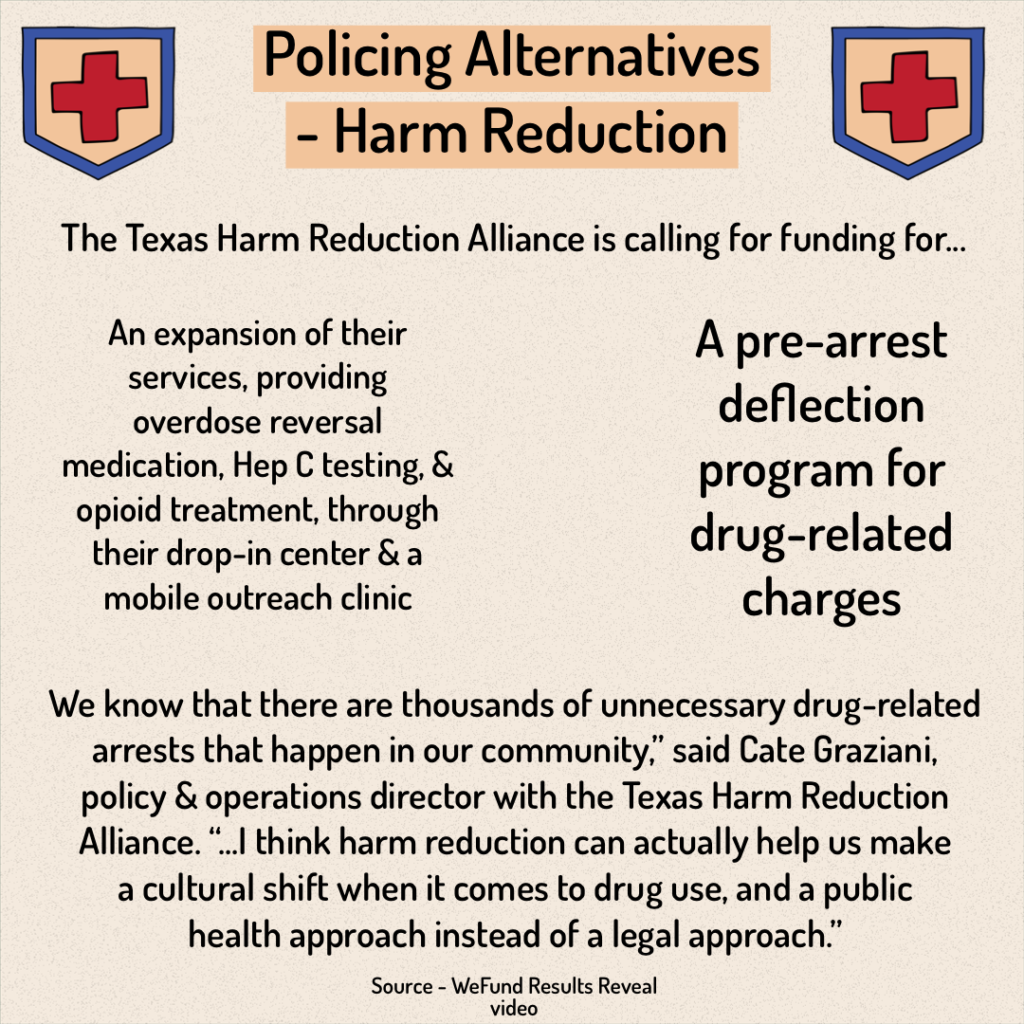
“We know that there are thousands of unnecessary drug-related arrests that happen in our community,” said Cate Graziani, policy & operations director with the Texas Harm Reduction Alliance. “…I think harm reduction can actually help us make a cultural shift when it comes to drug use, and a public health approach instead of a legal approach.”
Alternatives To Policing - Homelessness Services
Another area where advocates are pushing for change is in the way our police department interacts with people experiencing homelessness, as well as asking for more funding to prevent Austinites from becoming homeless in the first place.
According to the Ending Community Homelessness Coalition (ECHO) and its most recent Point In Time Count, Austin had 1,574 people sleeping unsheltered (on one specific night in January 2020). The Point In Time count also found that 36.5 percent of Austin’s homeless population is Black, despite the fact that Black people only make up 9 percent of Travis County’s population.
“Many, if not the majority of those folks, have had recent interactions with our criminal justice system, that continue to prevent them from accessing the quality and affordable health care and housing that they need,” explained Matt Mollica, executive director of ECHO on the WeFund Results Reveal livestream meeting.
To address this, ECHO is calling on City Council to:
Add a $38 million budget increase to go toward homelessness services & permanent supportive housing options
Provide funding to build 300 more units of permanent supportive housing
Provide funding to build 250 units of rapid rehousing (to help people experiencing a short-term housing crisis)
Dedicate $800,000 toward diversion services, to help people who just need one-time assistance in escaping homelessness (or prevent them from becoming homeless in the first place)
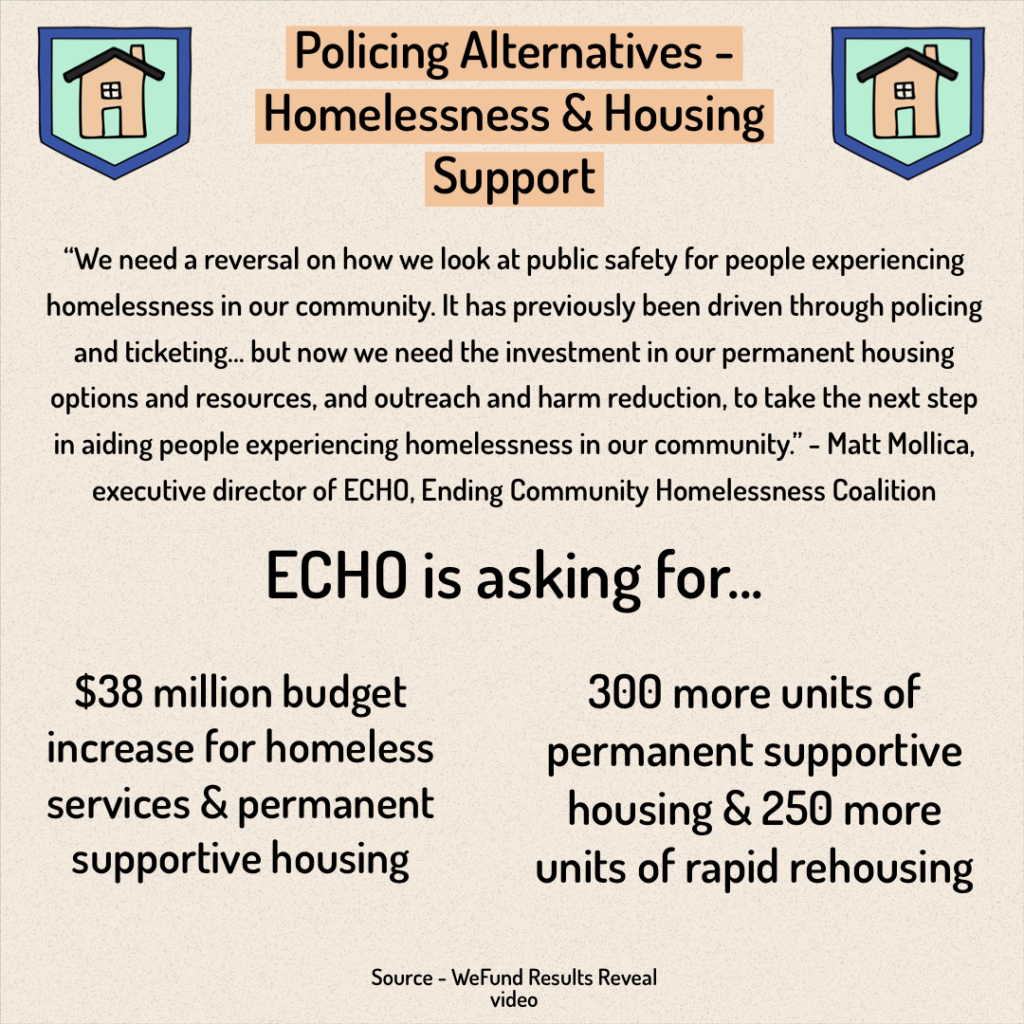
Now that city ordinances have been changed to prevent homeless people from getting tickets or being arrested for sleeping in public places, Matt says that, “we need a reversal on how we look at public safety for people experiencing homelessness in our community. It has previously been driven through policing and ticketing… but now we need the investment in our permanent housing options and resources, and outreach and harm reduction, to take the next step in aiding people experiencing homelessness in our community.”
Alternatives To Policing - Mental Health First Response
“On the mental health first response, this is one of the more popular and widely discussed ideas…,” explained Kathy Mitchell, of Just Liberty, at the WeFund Results Reveal livestream meeting. “Because Austin unfortunately has shot a lot of mentally ill people. I don’t say that lightly. I say that because it remains a kind of shocking truth. That when people call in a mental health crisis, they get, sometimes, a far too aggressive police response, and it has been very harmful.”
Selena Xie, president of the Austin EMS Association, explains it this way, “When we’re talking about conversations about policing, I do think there is a lot of duplication of services. So there are quite a few calls that both agencies go on that we don’t actually need police to be at.”
Selena points to calls involving overdoses, people experiencing homelessness, welfare checks, and mental health calls as examples of this.
To try and address this, Selena, Kathy, and other community organizers are calling for increased funding for EMS and initiatives like the Community Health Paramedic Program, allowing trained health care professionals to respond to mental health calls, instead of police officers.
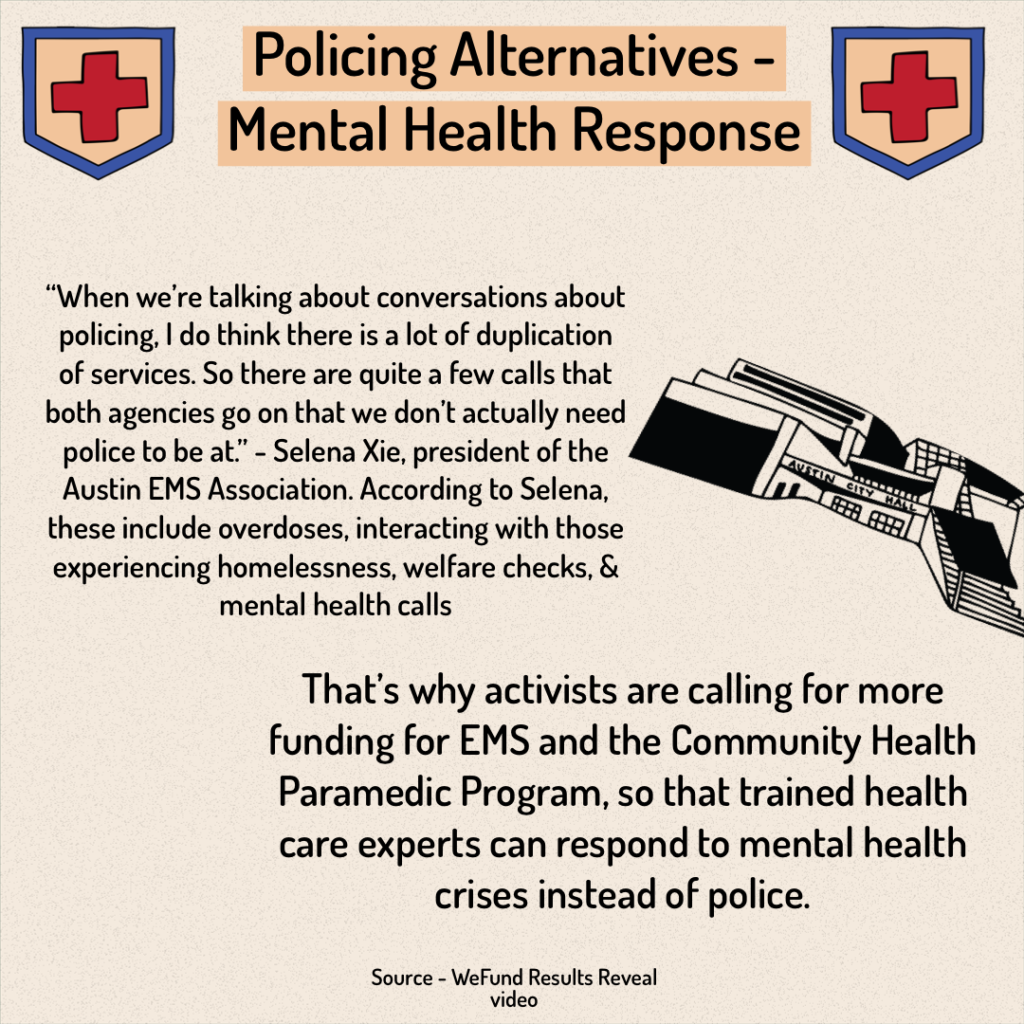
Alternatives To Policing - Violence Prevention
In addition to shifting what the police work on, many local activists are also pushing for ways to prevent violent crime in the first place.
At the WeFund Results Reveal livestream meeting, Amber Goodwin (a member of the City of Austin Gun Violence Task Force) explained that her and her fellow task force members are calling for $25 million over the next 5 years ($5 million a year) to:
Create an Office of Violence Prevention, independent from APD
Hire a firm to provide independent technical assistance in mapping out where gun violence is happening in Austin and what it costs the community
Invest in evidence-based strategies to prevent violence
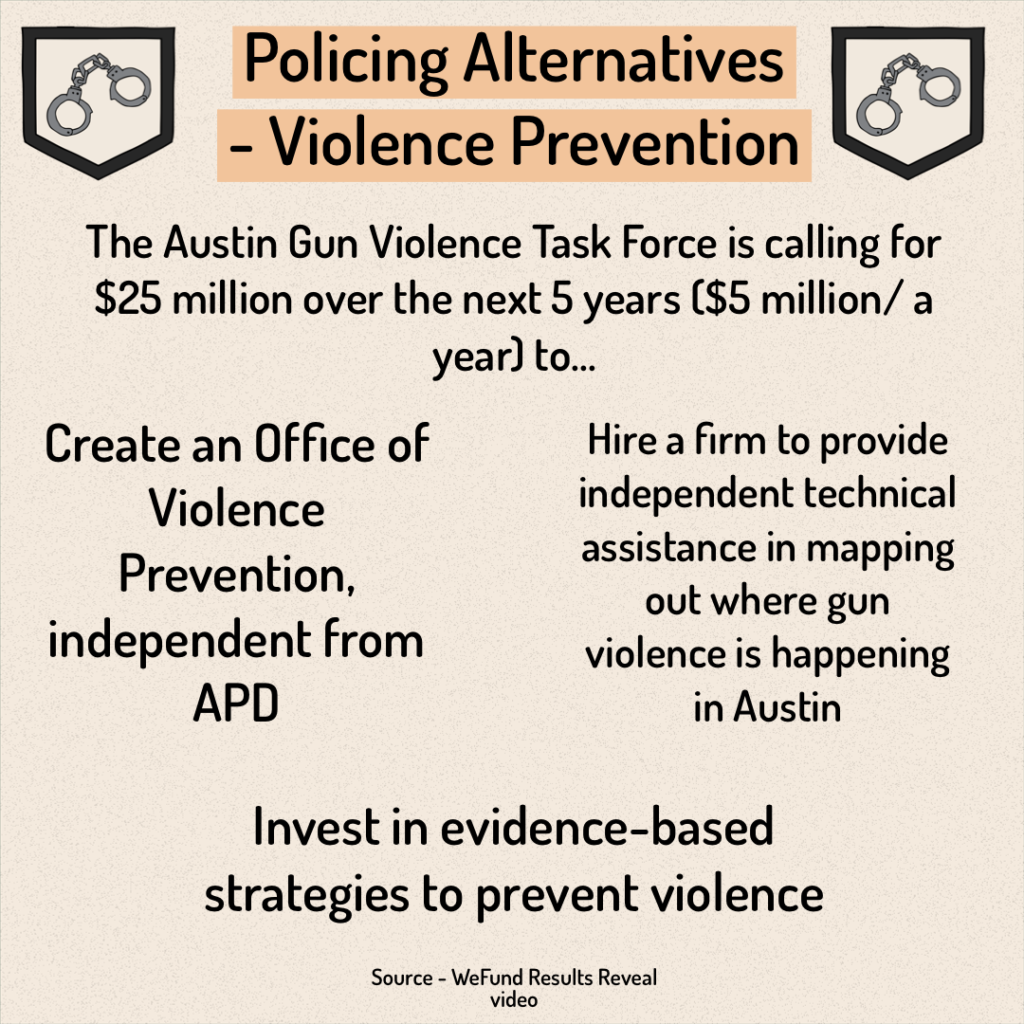
Alternatives To Policing: R.E.A.L Budget Framework
Communities of Color United, a local grassroots group that has been working on policing and the city’s budget for years, has put forth its own alternative to our current policing funding framework.
They’re calling on the city to cut APD’s budget by 50 percent this year and invest in the following programs instead…
RISE Funds – continue to invest more money into the RISE program, which was created in response to COVID-19 and provides a direct transfer of money to families in need
Equity Office – investing more money in the city’s Equity Office, so they have the resources to vet every major policy decision, expenditure, and proposal that affects housing, public health, safety, and the environment
Austin Public Health – investing additional money in the city’s public health department to address the long-standing health inequities faced by communities of color
Low income housing – invest in anti-displacement measures and more low-income housing
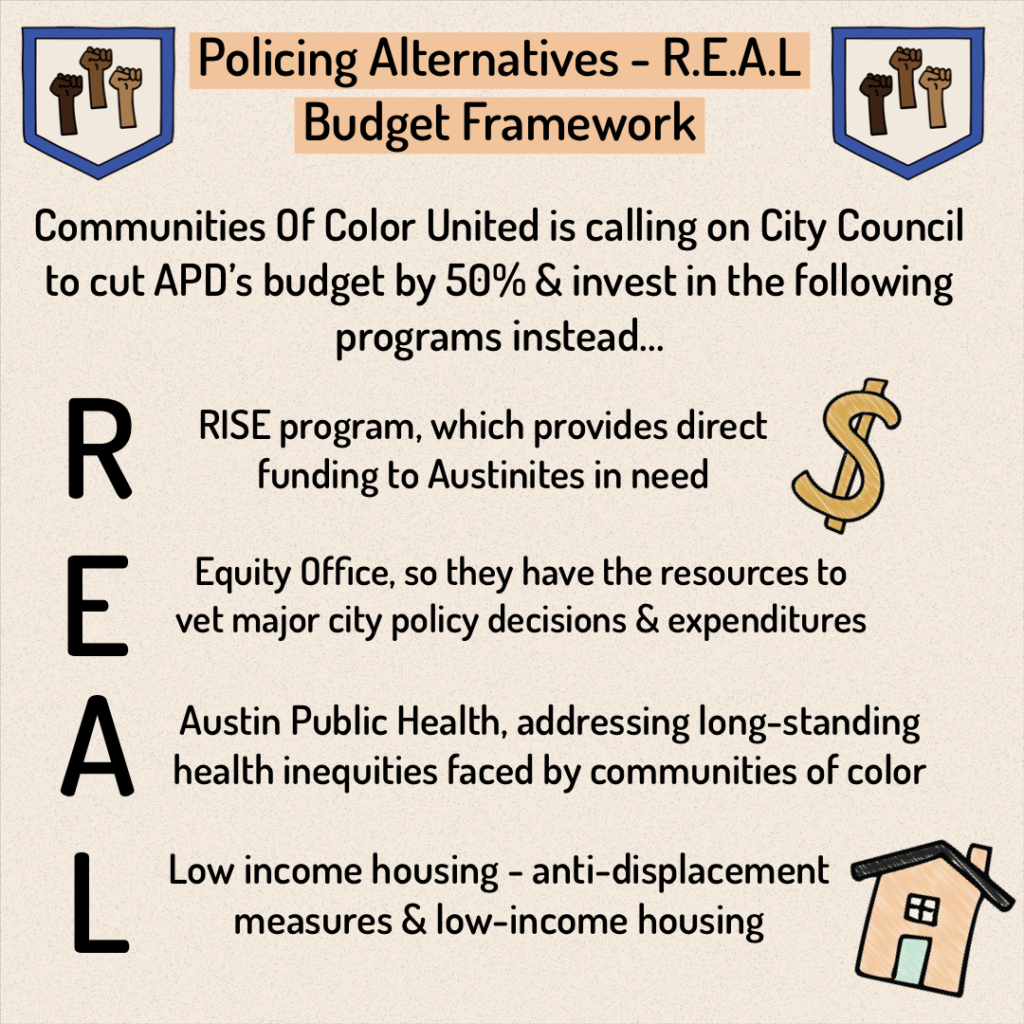
As CCU explains in an open letter (that they’re inviting community members to sign onto as well), “safety comes when people have dignified livable wage jobs, housing that is truly affordable, accessible transportation, equitable and beautiful public spaces, and culturally congruent health and wellness services. This is the role of a city government. We must invest in initiatives that help us strengthen our communities, address issues at their root, and prevent crises.”
What comes next? Going Beyond Reform
There have been a lot of conversations lately about how far to push for change in our police system. Should we make reforms to police policies and training? Should we defund the police and move their funding to other city programs and nonprofits? Should we abolish the police department all together?
In his interview with The Austin Common, Chris Harris put it this way.
“We’ve now gotten a good 4 or 5 year run with a good deal of reforms, and then we see, Mike Ramos still happen…,” he said. “A lot of folks that pushed for more training and body cams and a lot of the things that have been tried in the last five years, have to grant now that this hasn’t worked. And it’s not working. We’re not really seeing a change in the rate of police killing.
So what do we do? Well, there have been these folks who have been pushing all along to say, the issue isn’t the training or what policies are in place, the issue is that we’re relying on the police to begin with.”



